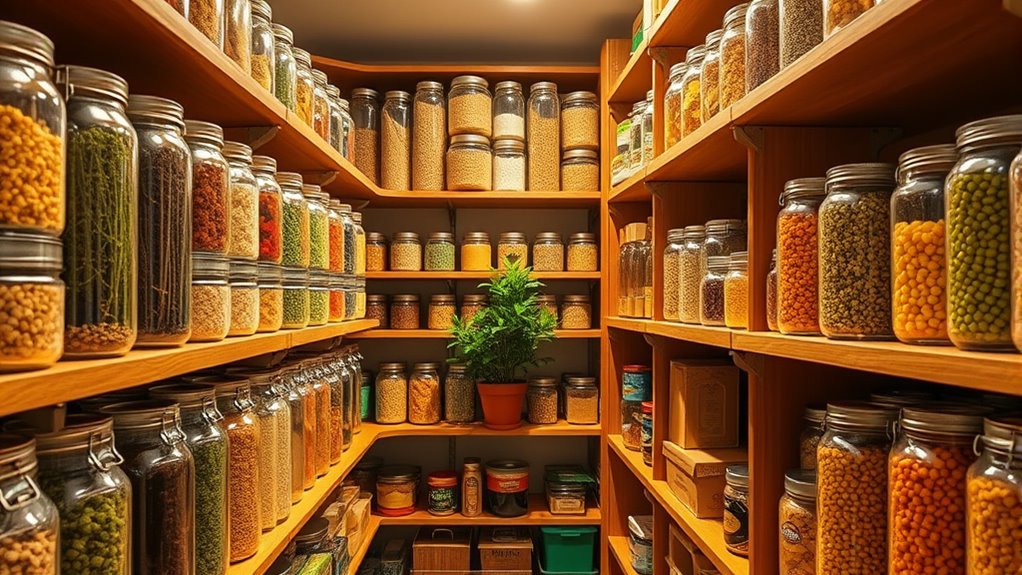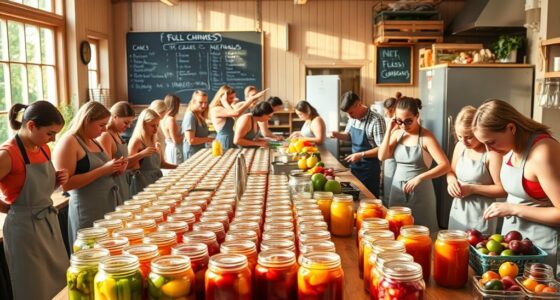To keep your pantry stocked and prevent running out, focus on proper rotation using the FIFO method, placing new items behind older ones. Regularly check for expired goods, organize by categories, and label containers with purchase and expiration dates. Use clear containers and designated spaces for essentials to make grabs quick and intuitive. Consistently applying these strategies guarantees freshness and availability — keep going, and you’ll discover more ways to master your pantry.
Key Takeaways
- Use FIFO to ensure older items are used before newer stock, preventing spoilage.
- Regularly audit your pantry to move older items forward and discard expired goods.
- Store items in clear, labeled containers for easy visibility and tracking of expiration dates.
- Designate specific zones for frequently used ingredients for quick access and efficient rotation.
- Maintain consistent organization and routines to make rotation automatic and pantry management seamless.

Imagine having a pantry that always has exactly what you need, no matter how often you open it. It feels like magic, but it’s really about smart rotation techniques that keep your supplies fresh and accessible. When you implement effective rotation strategies, you prevent waste, save money, and never find yourself scrambling for ingredients at the last minute. The key is understanding the principles behind proper rotation and applying them consistently.
First, you want to adopt a system that ensures older items are used before newer ones. The most common method is the FIFO system—”first in, first out.” With FIFO, you place the newest stock behind the older items on your shelves. When you need something, you reach for the oldest product first. This simple rule prevents expiration and spoilage. To make it easier, organize your pantry so that older items are more visible and accessible. Use clear containers for dry goods and label everything with purchase or expiration dates. This way, you’ll have a visual reminder of what needs to be used soon.
Next, you should regularly audit your pantry. Set aside time weekly or biweekly to check what’s inside. As you do, move items around so that the oldest are at the front or top. Discard anything past its expiration date or that you’re no longer interested in using. Take note of what you tend to buy in excess and what you actually use often. This insight helps you shop smarter and avoid cluttering your pantry with unnecessary items. When restocking, place new purchases behind the existing stock to maintain the rotation order. Incorporating proper storage techniques ensures your items stay fresh longer and remain easy to find.
Another helpful tip is to create a designated spot for frequently used ingredients. By keeping staples like rice, pasta, canned goods, or spices in easy-to-reach areas, you minimize the chances of forgetting what you have. This encourages you to use what’s already there before buying more. Additionally, consider using transparent containers with labels that include purchase or expiration dates. When you see the contents clearly and know their shelf life, you’re more likely to use items timely.
Finally, integrating a system of labels and organized shelves makes your rotation routine seamless. When you know exactly where everything is and the order in which it should be used, you reduce waste and frustration. Over time, this approach becomes second nature, turning your pantry into a well-oiled machine that’s always stocked with what you need, fresh and ready to go. With consistency, these practices will keep your pantry running smoothly, ensuring you’re never caught off guard or overwhelmed by expired or forgotten supplies.
Frequently Asked Questions
How Often Should I Rotate My Pantry Items?
You should rotate your pantry items every 3 to 6 months to keep everything fresh and avoid waste. Check expiration dates regularly and move older items to the front so you use them first. When restocking, place new items behind older ones to maintain a proper rotation. This way, you guarantee nothing expires unused, saving money and reducing food waste while keeping your pantry organized and stocked efficiently.
What Are the Best Storage Containers for Pantry Longevity?
You should choose airtight containers made of glass or BPA-free plastic for your pantry. Glass containers are durable, won’t stain or retain odors, and keep food fresh longer. BPA-free plastic options are lightweight and affordable, but make certain they are food-grade and have tight-fitting lids. Use clear containers to easily see contents and label them for quick identification. Properly sealed, these containers help extend shelf life and prevent pests.
How Can I Prevent Pests in My Pantry?
To prevent pests in your pantry, you should store all food in airtight containers, keeping them sealed tightly at all times. Regularly clean shelves and sweep up crumbs or spills promptly. Use natural pest repellents like bay leaves or cloves, and maintain a low humidity environment. Check for signs of pests weekly, and dispose of infested items immediately. Proper organization and cleanliness are your best defenses against pantry pests.
Which Foods Have the Longest Shelf Life?
You should stock foods like dried beans, rice, pasta, canned goods, and honey for the longest shelf life. These items can last years if stored properly in airtight containers and cool, dark places. Freeze or vacuum-seal perishable items to extend their freshness. Regularly check expiration dates, and rotate your stock to guarantee nothing goes to waste. Proper storage is key to keeping these foods safe and edible for a long time.
How Do I Organize My Pantry for Easy Rotation?
Think of your pantry as a well-oiled machine. To keep it running smoothly, organize items by type and expiration date, placing newer stock behind older. Use clear containers for visibility and label everything clearly. Regularly check for expired items and rotate stock, so nothing gets lost in the shuffle. This way, your pantry becomes a treasure chest of fresh, accessible ingredients, making meal prep quick and stress-free.
Conclusion
With a well-planned rotation, your pantry becomes an endless well of resources, never running dry. Think of it as a well-tuned symphony where each ingredient plays its part perfectly, ensuring variety and freshness. Stick to these rotations, and you’ll stay prepared, save money, and avoid waste. Your pantry will be a reliable friend, always ready to serve up what you need, like a garden that keeps blooming no matter the season.










